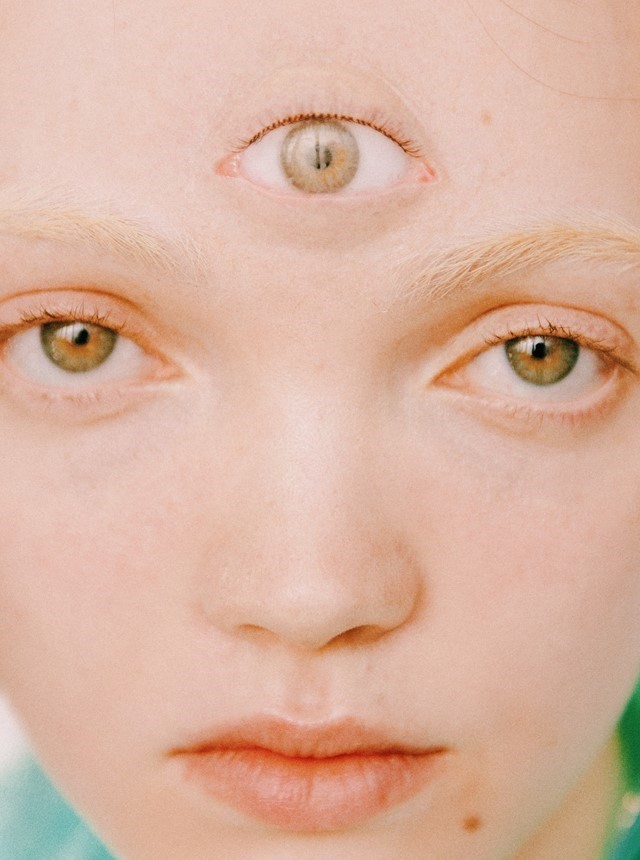The practice uses a series of flashing LED lights to stimulate the brain’s pineal gland and help achieve your full spiritual potential
Walking into New York City’s Kollectiv, an urban retreat centre in the middle of the East Village with hippie decor, I wasn’t sure what to expect. Stepping through the doors, I wound my way past a plant-based healing café stocking every herbal supplement possible, and down the staircase to the surprisingly dark spa area.
I was here to try Ajna Light therapy – hands down one of the weirdest wellness treatments I’ve ever experienced. According to Kollectiv, it’s a form of therapy that “uses a pulsing white light over your third eye, which stimulates the pineal gland, producing visuals of kaleidoscopes of colours and patterns” with the overall aim being to “bring you into a deeper state of meditation and unlock the creative centers of your brain.”
From helping you to reach your full spiritual potential – thus attaining an enlightened state – to increasing clarity, concentration and intuition, opening your third eye (or sixth chakra), often referred to as the connection between our body and our spirit, is said to promise a wealth of spiritual benefits. A simple Google search reveals that there are a million different ways to help open your third eye, which is also known as the pineal gland (a small gland in the brain that produces and regulates some hormones, including melatonin). Others include meditating with crystals or literally tapping your forehead, where your third eye is supposedly located. Whichever way you do it, the idea is based on activating your pineal and pituitary glands, whether it be through vibration or stimulation, or even intense concentration.
Walking into the small room where the treatment would take place, I was told to lay down on my back and put on a pair of headphones and close my eyes. Suddenly, the Ajna Light, a system of LED lights that flash to stimulate the pineal gland, hovering inches from me, was placed directly towards my face. “Have you done this before?” the receptionist who walked me to the room asked. “It’s fun,” she said, with a manic laugh.
Intensely bright lights started flashing in front of me. My eyes were closed, and yet I could still see a kaleidoscope of colours. I also started seeing computerised-looking numbers that scrolled by very, very fast. Playing through my headphones was a combination of computer sounds and new wave-sounding synth. The speed at which the lights were flashing made me immediately feel anxious and actually made me wonder if something bad was going to happen. What if it triggered something to make me have some kind of seizure or pass out? I admittedly opened my eyes a few times just to see what the lights actually looked like – a blur of LED colours connected to a piece of plastic – which made me feel less anxious.
Some Ajna Light sessions last for up to a full hour, but I only opted to try 15 minutes (at a cost of $45). It literally felt like a lifetime. Several times during the treatment, I had to turn my head to the side to avoid seeing the thousands of repeating, mysterious numbers scrolling by and vivid spheres of colours. The colours seemed to subside momentarily. Some of the numbers lit up and I wondered if I was receiving some kind of cryptic message. I’ve never done extreme drugs, but I imagine it might be a bit like this.
I couldn’t wait until the treatment was over – so much so that I admittedly checked my phone twice to look at the time. When it was, I walked outside and the receptionist asked how it was. I told her I saw lots of numbers. She laughed, and said she loves getting Ajna Light therapy to feel more creative.
“Intensely bright lights started flashing in front of me. My eyes were closed, and yet I could still see a kaleidoscope of colours. The speed at which the lights were flashing made me immediately feel anxious and actually made me wonder if something bad was going to happen”
According to the founder of the Ajna Light, Guy Harriman, who claims to have formerly worked in tech with Steve Jobs in Silicon Valley, I may have been experiencing “varied altered states of consciousness during Ajna Light journeys.” As he says, “This reflects the client's own changing inner awareness.” Harriman became a Buddhist monk in Thailand after leaving the US and built his first Ajna prototype in 2014. His official website also looks slightly outdated with a bunch of broken links.
The experience is “similar to the effects experienced by those who are advanced in mediation practice such as Buddhist monks,” according to the Zen Within Academy, which offers Ajna Light therapy as part of its practice. “The Ajna Light system uses LED lights, which flicker at specific frequencies to entrain the user’s brainwaves into a range of trance states. These trance states range from a light relaxing state to the deepest of meditative states. In the trance state, our mental defences are lowered, and we are open to a greater awareness than our typical controlling egoic mind patterns.” The ‘therapy’ only has a temporary effect. “The advantage of using the Ajna Light is that it does not change the brain chemistry, and therefore the effect stops as soon as the lights stop.”
There’s obviously a niche of people who enjoy the treatment, as seen by the many reaction videos on YouTube. But psychologists caution that Ajna Light is not the same thing as actual ‘light therapy’. “People with mood disorders, especially seasonal affective disorder can successfully use light therapy to help shift their mood,” says Quinn Austin-Small, Ph.D. “Likewise, folks who travel frequently or are traveling across multiple time zones can ease or prevent jet lag by using light therapy to trick their brain into thinking it’s day time or night time.”
However, Austin-Smalls believes Ajna Light therapy is a hoax with no reliable scientific research, lots of jargon, and no proven evidence that it can help people in a theurapedic or medatative way. “Ajna Light, at best, is an utter hoax, and at worst may be dangerous for the eyes. No studies have proven any of what he (Harriman) says, and his lighting isn’t tested or standardised in any way,” he adds.
People on Reddit have also cited that someone with the most basic programming experience can easily make their own Ajna Light for a fraction of the thousand-dollar price tag, and that the whole reasoning behind using one is to get a DMT (a hallucinogenic tryptamine drug that occurs naturally in plants and animals) experience without taking any drugs. In fact, there are also other, similar treatment systems from other creators. The Lucia No. 3, for example, created by neurologist and psychologist Dr Dirk Proeckl and psychologist and psychotherapist Dr Engelbert Winkler, consists of flashing LED lights. Interestingly, Ajna Light therapy and its similar services still remain extremely niche. Kollectiv is the only place I’ve come across where you can try this service in all of New York City.
So, while I don’t think I found my opened my third eye or even went into a meditative trance during the experience, it was an interesting one. But I wouldn’t do it again, unless I was extremely desperate to repeat the extremely weird process again for whatever reason. To be honest, I hated the entire therapy and how it made me feel – which was the opposite of relaxed and slightly suspicious. I’ve tried a lot of strange wellness and beauty treatments but this was by far the only one I wanted to get out of as soon as possible. I think I’ll stick with yoga to try to open my third eye for now.




